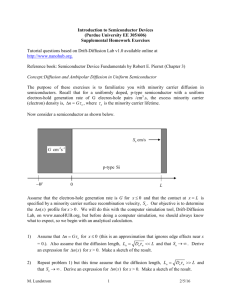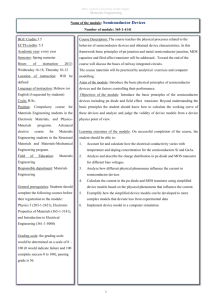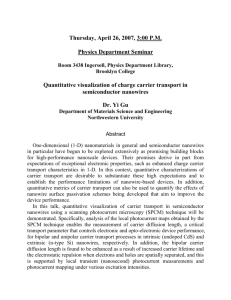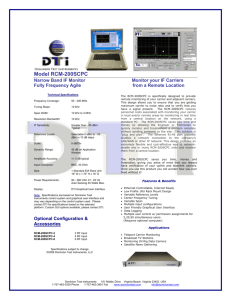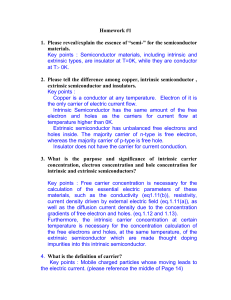Problem 3:
advertisement
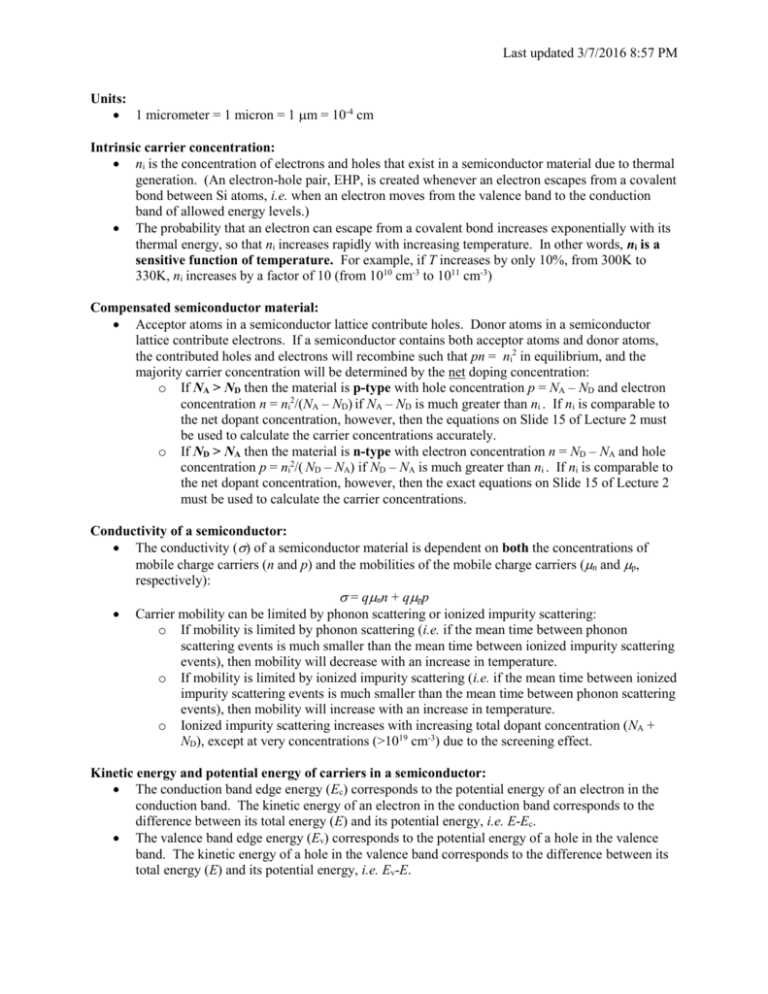
Last updated 3/7/2016 8:57 PM Units: 1 micrometer = 1 micron = 1 m = 10-4 cm Intrinsic carrier concentration: ni is the concentration of electrons and holes that exist in a semiconductor material due to thermal generation. (An electron-hole pair, EHP, is created whenever an electron escapes from a covalent bond between Si atoms, i.e. when an electron moves from the valence band to the conduction band of allowed energy levels.) The probability that an electron can escape from a covalent bond increases exponentially with its thermal energy, so that ni increases rapidly with increasing temperature. In other words, ni is a sensitive function of temperature. For example, if T increases by only 10%, from 300K to 330K, ni increases by a factor of 10 (from 1010 cm-3 to 1011 cm-3) Compensated semiconductor material: Acceptor atoms in a semiconductor lattice contribute holes. Donor atoms in a semiconductor lattice contribute electrons. If a semiconductor contains both acceptor atoms and donor atoms, the contributed holes and electrons will recombine such that pn = ni2 in equilibrium, and the majority carrier concentration will be determined by the net doping concentration: o If NA > ND then the material is p-type with hole concentration p = NA – ND and electron concentration n = ni2/(NA – ND) if NA – ND is much greater than ni . If ni is comparable to the net dopant concentration, however, then the equations on Slide 15 of Lecture 2 must be used to calculate the carrier concentrations accurately. o If ND > NA then the material is n-type with electron concentration n = ND – NA and hole concentration p = ni2/( ND – NA) if ND – NA is much greater than ni . If ni is comparable to the net dopant concentration, however, then the exact equations on Slide 15 of Lecture 2 must be used to calculate the carrier concentrations. Conductivity of a semiconductor: The conductivity () of a semiconductor material is dependent on both the concentrations of mobile charge carriers (n and p) and the mobilities of the mobile charge carriers (n and p, respectively): = qnn + qpp Carrier mobility can be limited by phonon scattering or ionized impurity scattering: o If mobility is limited by phonon scattering (i.e. if the mean time between phonon scattering events is much smaller than the mean time between ionized impurity scattering events), then mobility will decrease with an increase in temperature. o If mobility is limited by ionized impurity scattering (i.e. if the mean time between ionized impurity scattering events is much smaller than the mean time between phonon scattering events), then mobility will increase with an increase in temperature. o Ionized impurity scattering increases with increasing total dopant concentration (NA + ND), except at very concentrations (>1019 cm-3) due to the screening effect. Kinetic energy and potential energy of carriers in a semiconductor: The conduction band edge energy (Ec) corresponds to the potential energy of an electron in the conduction band. The kinetic energy of an electron in the conduction band corresponds to the difference between its total energy (E) and its potential energy, i.e. E-Ec. The valence band edge energy (Ev) corresponds to the potential energy of a hole in the valence band. The kinetic energy of a hole in the valence band corresponds to the difference between its total energy (E) and its potential energy, i.e. Ev-E. Last updated 3/7/2016 8:57 PM Recombination-generation (R-G) of carriers in silicon: Under low-level injection conditions, the net rate of electron-hole recombination is dependent on the excess carrier concentration. In general, the net rate of recombination is proportional to (np ni2) R-G always acts to restore a system to equilibrium. o If the excess carrier concentrations (n and p) are greater than zero (so that np > ni2), then there will be net recombination of carriers. o If the excess carrier concentrations are less than zero (so that np < ni2), then there will be net generation of carriers, i.e. the net recombination rate is negative. o In equilibrium, the carrier recombination rate equals the carrier generation rate, so that the net rate of recombination is zero. Quick determination of carrier concentrations and Fermi level: The position of the Fermi level relative to the intrinsic Fermi level can be quickly deduced by remembering that kT ln(10) = 60 meV: o EF-Ei = kT ln(n/ni). If n = 10M cm-3 then log (n/ni) = M-10 so EF-Ei = (M-10) × 60 meV o Ei-EF = kT ln(p/ni). If p = 10M cm-3 then log (p/ni) = M-10 so Ei-EF = (M-10) × 60 meV If |EF-Ei| is a multiple of 60 meV, then the carrier concentrations can be quickly deduced: o If EF-Ei = M × 60 meV then n = 10M+10 cm-3 o If Ei-EF = M × 60 meV then p = 10M+10 cm-3 Schottky contact: The magnitude of the built-in potential (Vbi) is related to the Schottky barrier height (B) and location of the Fermi level (EF) in the flatband region of the semiconductor: o For a metal contact to n-type semiconductor: |qVbi| = Bn – (Ec – EFS)FB For a metal contact to p-type semiconductor: |qVbi| = Bp– (EF – Ev)FB Ideally, this is equal to the magnitude of the difference between the metal work function and the semiconductor work function. In practice, however, this is almost never the case due to trapped charge at the metal-semiconductor interface. A true ohmic contact (M < S for contact to n-type semiconductor, or M > S for contact to ptype semiconductor) is never seen in practice. A Schottky contact can be made to be practically ohmic (allowing current to easily flow in both directions) by doping the semiconductor very heavily so that the width of the depletion region is very narrow (<10 nm) to allow electrons and holes to tunnel easily through it. Illumination of a semiconductor with light: Electron-hole pairs (EHPs) can be generated within a semiconductor sample by irradiating it with light. The rate of EHP generation, GL, is dependent on the intensity of the light. The rate at which holes and electrons recombine is proportional to the excess carrier concentration. (The more excess carriers there are, the less time it takes for an electron and hole to meet and annihilate each other.) The recombination rate is inversely proportional to the minority carrier lifetime . (The lifetime is the average time that a minority carrier “survives” before it is annihilated by recombination; so the smaller the lifetime the higher the rate of recombination.) If the electric field within a semiconductor sample is negligible, then the carrier concentrations within it can be increased by irradiation. As the carrier concentrations (and hence the excess carrier concentrations) increase, the rate of recombination increases. Eventually, the rate of generation (GL) will equal the rate of recombination (p/p for n-type semiconductor,n/n for ptype semiconductor) and a steady state will be reached (when p = GLp for n-type semiconductor,n = GLn for p-type semiconductor). Last updated 3/7/2016 8:57 PM Current flow in a pn junction diode: Charged mobile carriers contribute to current flow via diffusion and drift mechanisms. At various locations along the diode (from the p-side contact to the n-side contact) the total current is the same, but the components of current (hole drift, hole diffusion, electron drift, electron diffusion) can be different, as shown in Lecture 10 Slide 4. Due to the large carrier concentration gradients, there is a strong tendency for holes to diffuse to the n-type side and for electrons to diffuse to the p-type side. The built-in potential counteracts this. The only carriers that diffuse across the junction (to become minority carriers on the other side) are those that have sufficient kinetic energy to overcome the potential barrier. In equilibrium, a very small amount of majority carriers diffuse across the junction; this diffusion current is exactly cancelled out by the very small amount of minority carriers that drift across the junction. (One can say that the diffusion current is balanced by the drift current in the opposite direction.) A forward bias (VA > 0) reduces the potential barrier to carrier diffusion. The number of carriers with sufficient kinetic energy to overcome the potential barrier increases exponentially with decreasing barrier height - due to the exponential distribution of electrons and holes within the conduction and valence bands (ref. Lecture 3 Slides 7 and 8 - and hence the diffusion current flowing across the junction increases exponentially with increasing forward bias. The drift current flowing in the opposite direction does not depend on the potential barrier height. Therefore, under forward bias the diode current is dominated by majority carrier diffusion across the junction, increasing exponentially with increasing forward bias voltage. Generally, the more heavily doped side contributes more to carrier diffusion (hence current flow) across the metallurgical junction under forward bias. The majority carriers which diffuse across the metallurgical junction become minority carriers diffusing within the quasi-neutral regions on the other side. This is referred to as “minority carrier injection” under forward bias. o The minority-carrier diffusion length is the average distance that a minority carrier “survives” before it is annihilated by recombination. The shorter the minority-carrier diffusion length, the more rapidly the minority-carrier concentration goes to zero within the quasi-neutral region, i.e. the steeper the minority-carrier concentration profile and hence the larger the minority-carrier diffusion current. This is why each component of the diode current is inversely dependent on the minority-carrier diffusion length. A reverse bias (VA < 0) increases the potential barrier to carrier diffusion, so that the number of carriers with sufficient kinetic energy to overcome the potential barrier decreases exponentially with decreasing barrier height and becomes negligible as compared to the drift current flowing in the opposite direction. Therefore, under reverse bias the diode current is dominated by minority carrier drift across the junction, which is a weak function of reverse bias voltage. Since the minority carrier concentration is greater on the more lightly doped side, it contributes more to current flow across the junction under reverse bias. The minority carriers which drift across the metallurgical junction become majority carriers within the quasi-neutral regions on the other side. This is referred to as “minority carrier collection” under reverse bias. Carrier concentrations within the depletion region of a pn junction diode: Under forward bias, the product of the carrier concentrations (not each individual carrier concentration) within the depletion region is greater than in equilibrium. Each of n and p can be much less (more than 10× smaller) than the ionized dopant concentration within the depletion region, which is why the depletion approximation is valid. Within the depletion region (which is not in equilibrium when VA 0 due to the significant electric field within this region), the electron and hole concentrations can be tracked using the quasi-Fermi levels. It can be shown that FP and FN do not change significantly within the depletion region; due to energy-band bending within the depletion region, however, FP -Ev and EcFN change monotonically within the depletion region and the carrier concentrations decay ~exponentially (from pp to pn for holes; from nn to np for electrons) across the depletion region. Last updated 3/7/2016 8:57 PM pn junction diode with narrow quasi-neutral region If the quasi-neutral region is much shorter than the minority-carrier diffusion length, then ~all of the injected minority carriers will diffuse to the metal contact before recombining with majority carriers there. In other words, ~none of the minority carriers will be annihilated by recombining with majority carriers within the quasi-neutral region and hence the minority-carrier diffusion current will not decay with distance, i.e. it will be ~constant throughout the quasi-neutral region. This means that the gradient (slope) of the minority-carrier concentration profile is constant, i.e. the minority-carrier concentration is a linear function of distance, going from its value at the depletion-region edge to zero at the metal contact. o The gradient of the minority-carrier concentration profile becomes steeper as the quasineutral region becomes narrower. Therefore, the minority-carrier diffusion current increases with decreasing quasi-neutral region width if it is much shorter than the minority-carrier diffusion length.


